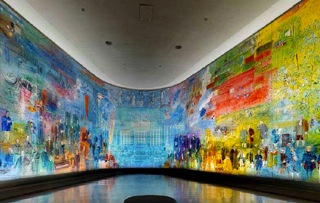text by Izhar Patkin
written for the Raoul Dufy catalog (2008) Musée d'Art Moderne de la VIlle de Paris
Once upon a time I asked my father where electricity came from
My father, Aryeh Patkin, was an electrical engineer by profession. I was four or five or six, I am not sure that I understood what engineer meant but I knew he got up very morning for the Israel Electricity Company. Turned out he specialized in implementing techniques for handling live high voltage wires - live mega million watt wires! God forbid the buzz would stop for a single minute!
We sat down and he whipped up pages and pages of magical drawings. First, ships delivering coal to the power plant in Haifa Bay1; then fire and heat and steam turbines. The mysterious smoking chimneys like giant yogurt-jars were a winner

Electric poles and wires carried free ions made up of little dots, dashes and arrows; transformation stations and fuse boxes; and at the end of the line, my mother with the vacuum.
“I guess all you wanted to hear was that electricity came out of the wall outlet,” he said laughing. The tabletop was completely covered with his pen and paper sketches.
“Cool. Now will you draw me a chicken dancing on an egg?” I asked.
He did a good one.
“Now a chicken dancing on a globe,” I implored.
He did a good one.
“Wow, thanks! I am going to learn how to draw when I grow up.”
Decades later, on his dying bed, his last words to me were: "All my life I was seen an engineer, but my deeper story was firstly of a sentimental man, I know you can understand this, you are an artist and you had success at it"
“Sentimental about what?” I wanted to know.
“About building things. Town and country. Even an electric grid.”
Once upon another time I met a fairy. Holly Solomon2. A soul mate, a friend, a glamorous rebel, a genius, hah, she was also my Art dealer... On a trip to Paris, she introduced me to Raoul Dufy's Electric Fairy. She had a plan.

Raoul Dufy's "La fee electricite" (1937)
Musée d' Art Moderne de la Ville de Paris
Standing in the middle of the Dufy painting, which was covering an entire oval-egg-shaped room, there was not much to explain to each other; a nod and a smile was plenty. I had just finished The Black Paintings33, which covers four walls of a grand room; a painting you walk into.
Dufy's oval room is a grid of frescos; my rectangular room is a sequence of black rubber curtain pleats. A story of time and illumination flows through both paintings.
The Black Paintings is a narrative based on Jean Genet’s The Blacks; a Clown Show. My black, like Genet’s, is not a metaphor for a guzzler of white light, but rather a canvas for twinkling stars & lunar hide and go seek. With metaphor, it does not matter where electricity comes from, or if fairies, cupids or chickens flapping their wings generate it. Metaphor does not care what comes first; the chicken or the egg? Nor does it matter whether time ends or starts at dusk or dawn. "They all have their exits and their entrances.4" What matters is assertive transformation.
“God forbid the electric buzz would stop for a single minute,” I said to Holly. “On second thought, forget God. Who cares? Didn’t he quit Paris with the Enlightenment and again with the Nazis? Isn’t it amazing to think that La Fee Electricite was first unveiled along side the Nazi pavilion, Soviet pavilion and Guernica at the Exposition Internationale des Arts et Techniques dans la Vie Moderne in1937, all at the same time…”
“What God?” she laughed. “It seems that there is an earthly conspiracy to turn off Dufy's power. You are forbidden to like Dufy if you want to be considered serious. You must choose! Matisse or Dufy. Period,” she protested.
“It is marvelously appalling to mention Dufy to a knowing connoisseur, worse than an electric shock,” I laughed.
“See why I did the Dufy show two years ago?” she said as we walked out of the painting. “Hey, wanna paint my dining room? Rubber curtains? All around?” she winked. “Hungry already? We can discuss over Mont Blanc at Angelina’s.”
PS.
I didn’t mention the connection to Nam June Paik’s robot bride. It is part of the same story, but in another time. Do your own research5.
1. Patkin was born in Haifa, Israel, 1955. The Israel Electric Company is located in Haifa Bay. Its futuristic chimneys are very prominent fixtures in the bay’s landscape.
2. Patkin showed at the Holly Solomon Gallery from 1981 until Holly passed away in 2002.
In 1984, the Holly Solomon Gallery presented a show of Dufy’s work that sparked new “concise introduction to the range of Dufy's achievement” John Russell, New York Times, November 9, 1984. The show included ''The Black Cargo Boat.''
3. Izhar Patkin, The Black Paintings, 1985-86. 14”h X 22”w X 28”L.
Collection; Museum of Modern Art, NY.
A grand scale room of painted black rubber curtains based on Jean Genet’s play The Blacks: A clown show.
4. William Shakespeare; As You Like It
5. During the late 80’s and the early 90’s, Paik and Patkin collaborated on numerous works |